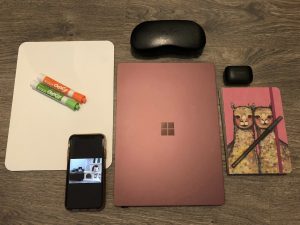
Click here for What’s In My Bag ASMR
I’ve decided to demonstrate what is in my bag using a relatively new concept – ASMR. ASMR initially stands for autonomous sensory meridian response. ASMR began from a forum discussion in 2007 and gained popularity from 2010 till the present day which has become a global sensation. In 2010, Jennifer Allen, a participant in an online forum, proposed that the phenomenon be named “autonomous sensory meridian response” (Keiles, 2019). Allen chose the words intending or assuming them to have the following specific meanings:
- Autonomous – spontaneous, self-governing, with or without control
- Sensory – about the senses or sensation
- Meridian – signifying a peak, climax, or point of highest development
- Response – referring to an experience triggered by something external or internal
I’ve picked two ASMR videos created by two YouTubers that had used items in my bag and merged their videos into one video file. I tried to create my own ASMR video, but without proper equipment it was unusable. At the beginning of the video, the first YouTuber flipped the pages gently and wrote in the notebook. She also typed on a keyboard halfway through the video. Near the end, the second YouTuber wrote on a whiteboard using a whiteboard marker, creating a distinctive screeching sound and erased everything at the end of the video. I’ve selected ASMR as a different medium to represent the items in my bag because the sounds in the video are all relatable to global listeners as “what is appropriate for all in the context of the ever more critical factors of local diversity and global connectedness” (The New London Group, p. 61). Similar to listening to a podcast where listeners submerge in the detailed story or information spoken to them through various devices. ASMR is primarily done through videos and as a listening file as well. The main difference is that ASMR is more for a calming and soothing effect. Listeners can select sounds and activities that make them feel comfortable for them to relax or able to work along with the sound as a new form of white noise. Instead of creating a video about what is in my bag, I think this is a nice change for listeners to hear familiar sounds done in a soothing way that might inflict some positive memories while they are working.
ASMR bakery. (2019). ASMR Study With Me page turning and tapping, writing, drawing [YouTube video]. YouTube. Retrieved from https://www.youtube.com/watch?v=8X7kNfT6f2g&t=1310s
ASMRSurge. (2015). ASMR writing and drawing with a marker on a whiteboard [YouTube video]. YouTube. Retrieved from https://www.youtube.com/watch?
, J. (2019). How A.S.M.R. Became a Sensation. The New York Times Magazine. Retrieved from https://www.nytimes.com/2019/04/04/magazine/how-asmr-videos-became-a-sensation-youtube.html
I have misophonia, so I couldn’t get all the way through your remix of the videos, but I appreciate the popularity and cultural relevance of the ASMR medium and how you’ve taken this creative approach!
Hi Mel,
I thought it was very interesting that you are able to try and enjoy ASMR given your condition. Thanks for letting me know, I appreciate it! At the same time, I also thought it was interesting because misophonia is the complete opposite of what ASMR is trying to achieve as ASMR is to elevate the auditory experience.